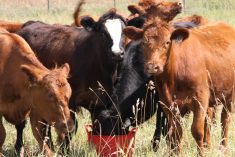CALGARY – Beef producers are finding something exciting going on in Manhatten.
That’s Manhatten, Kansas where a beef co-operative focusing on quality and value-added meat production is hoping to put more money in producers’ jeans.
It’s a new attitude. Cattle moving through the co-operative will be identified individually and producer members will receive printouts on carcass merit. When shareholders see how each animal grades and yields they can start overhauling breeding and management programs.
“Our (existing) system hasn’t been set up to reward improved production and improved quality. Hopefully this will help do that so people really can make a full-time living running beef cattle,” said Bill Miller, chief marketing officer for U.S. Premium Beef Ltd.
Read Also

Animal protection delivery to change in Saskatchewan
The Saskatchewan government is looking for a new agency to handle animal welfare after Animal Protection Services of Saskatchewan decided not to renew its contract next year.
U.S. Premium Beef is the second beef co-operative to form in the United States and Canada. Its focus on better beef should ultimately pay participating cattle producers a greater share of the profits.
“We are very squarely focused on the fact that the U.S. beef industry has lost 24 percent of its market share in the last 20 years to pork and poultry. During that same time period we’ve lost a half a million beef producers,” Miller said.
“Consumers are telling us with their pocketbooks that they’re not happy with what we’re producing for them.”
Members of the co-operative, who have so far pledged 750,000 head, insist cattle can be tracked individually in the system from farm through feedlot and packer to store shelves. The hog industry is their proof.
Big changes seen
“In our hog industry in 1989, 15 percent of the hogs were sold on an individual carcass merit basis. Today that number is 70 percent. That’s a 466 percent change in seven years,” said Miller.
The interim board of directors consists of five Kansas beef producers. All members of the co-operative must be producers whether it be as purebred farmers, cow-calf operators, backgrounders or feedlot operators. They’re also drawing interest from some Nebraska and Colorado producers.
Cattle producers pay $500 (U.S.) for a membership and 50 cents a head for each animal committed for delivery, hopefully next year. Shares will likely sell for between $50-$75 once the co-op is ready to roll.
Manhatten is about 190 kilometres west of Kansas City. Kansas is the third-largest feeding area in North America, tallying five million finished cattle a year.
Organizers haven’t decided whether to hire a company to custom kill, or lease or build their own slaughter plant.
Northern Plains co-op
Further north, a co-operative of Canadian and American producers is also moving ahead.
Ryan Taylor of Northern Plains Premium Beef based in North Dakota said their project has 431,000 head committed as of this September. There are 3,341 contributors.
An equity drive will be held in December and January with shares selling for $60.
To help pay for development costs, organizers received grants of $75,000 through the United States Department of Agriculture. The South Dakota governor’s office provided a $50,000 business development grant, said Taylor.
The company’s business plan also involves negotiating with a venture capital partner. Organizers are looking for a place to custom kill cattle but they haven’t determined how much kill capacity they will need.
Producers from North and South Dakota, Minnesota, Montana, Wyoming, Nebraska, Iowa, as well as Saskatchewan and Manitoba are involved. Core support comes from the Dakotas with 2,000 members, said Taylor.
The co-operative already has a full slate of members. Only those holding shares will be able to market and process cattle through the co-operative.
“Now that we have closed down our seed money we are essentially closed. Those folks who contributed the seed money will have the opportunity to buy the shares. The folks who don’t have seed money in right now won’t likely have the chance to buy shares,” said Taylor.
While packing plant concentration has been debated at length in the U.S. this year, the co-operatives’ said that issue wasn’t their impetus for forming.
“Like everyone on the Prairies, we’re producers of a raw product. We really feel we need to add value to it, participate up the stream so we can capture more of the food dollar,” said Taylor.















